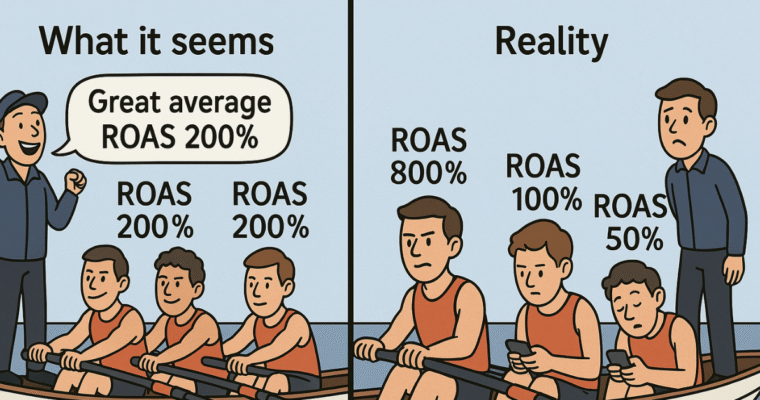Here’s what your paid traffic contractor might tell you:
“We’re hitting 300% ROAS. That’s optimal. If we lower bids, we’ll lose volume.”
Sounds safe. Logical. But here’s what’s actually happening:
That 300% is just an average.
Inside it, there are segments delivering 800–1000% ROAS. And others that are simply burning your money. But you don’t see them, because the good ones carry the bad ones on their back.
So yes — part of your budget is going to useless traffic.
But it gets worse.
Some of the “working” traffic is overpriced. You’re paying premium rates to reach audiences that would convert just as well at half the cost.
It’s like giving a factory worker a CEO salary — and expecting him to build 100x more. He won’t. He’ll smile, work at the same pace, and enjoy the paycheck.
This is why you’re missing profit.
- You’re paying too much for okay traffic.
- You’re funding weak segments without knowing it.
- Your “average performance” is hiding all of this.
And it’s not your fault. You weren’t supposed to know this — it’s not your job to dig into ad data.
But now that you do know, the real question is:
How much have you already lost?
There’s a better way.
I break campaigns down by segments — zip codes, time of day, keywords, product groups, etc. Each one gets its own rulebook. We stop overpaying for what doesn’t need it, and we drop what never worked in the first place.
Same budget. More profit.
Not by magic. Just by seeing the full picture — and acting on it.
Case-study 1:
We did this for a multi-location entertainment brand in LA.
Instead of using radius targeting, we analyzed actual postal codes — because distance alone wasn’t the full story.
- Some nearby zip codes had low-income audiences and didn’t convert — we excluded them.
- Some farther areas converted well due to easy transport access — we kept them.
- Some nearby areas had too much local competition — people had more options within walking distance, so conversion rates dropped. Even though they were close, we had to lower bids due to lower efficiency.
We reshaped the budget based on real behavior, not assumptions.
ROAS jumped from 200% to 320%. More profit. Less waste.
Case-study 2:
We did this for a home renovation materials client.
Most sales happen over the phone, so they ran ads only during office hours — assuming that’s when quality leads come in. ROAS was solid at 600%.
But we tested an off-hours campaign with lower bids. It brought fewer leads — but many were solid. When managers called them back the next day, they closed well.
This “quiet” campaign now adds nearly 50% in extra revenue — at a much lower cost.
If both time segments ran together in one campaign, the mixed ROAS would look weaker — and no one would realize there’s a high-profit opportunity hiding under the surface.
We didn’t settle. We looked deeper. That’s why it worked.
If you feel your ads are “doing okay,” that might be the problem.
Let’s take a look.
